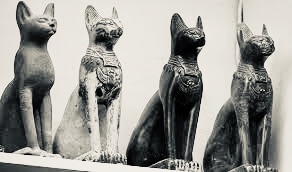
(above) Egyptian families loved their cats and mourned together when they died, very much like pet owners do today.
CATS (Felis catus)
On May 11, 2020 The City Of Rahway passed Resolution AR-120-20: ‘Resolution Supporting Responsible Pet Ownership Programs In The Community’. Cat owners and cat lovers should read this important information at the bottom of this article.
THE HISTORY OF CATS & HUMANS
In ancient times long before recorded civilization, roaming tribes of humans were followed by rodents, mice and rats which were very destructive to stored crops. In Asia Minor cats began to follow these nomads, feasting on the rodent populations. This new relationship was welcomed by humans who saw cats as their protectors. This was the first major step in the domestication of cats.
The second step came as early as 4,000 years ago when ancient Egyptians domesticated cats.
Imagine living in a time and place where every home was teeming with tiny, dangerous beasts. Some new threat lurked at every corner, snakes hiding in clay jars, rats spoiling massive amounts of stored grain, venomous scorpions creeping under cradles. In this time and place in ancient Egypt, one creature existed that could make the world safer from these little monsters, the cat.
Like their wild relatives, domestic cats are natural hunters able to stalk prey and pounce with sharp claws and teeth. They are particularly effective at night, when their light-reflecting eyes allow them to see better than much of their prey. Cats also enjoy acute hearing. All cats are nimble and agile, and their long tails aid their outstanding balance.
Soon after their introduction to Egypt, the Egyptian religion began to worships cats as gods and created laws making injuring or killing cats a punishable crime. One of the earliest deities of ancient Egypt was the goddess Mafdet, who was highly revered by people seeking protection against venomous animals like snakes and scorpions. She was shown with a variety of fierce, feline forms, most often as a woman with the head of a lion, cheetah, or house-cat. Because cats could protect against the tiny monsters that made Egyptian homes unsafe, Mafdet was regarded as the protector of the home and of the kingdom itself!
As Egyptians truly domesticated their cats, making them valued family members rather than just semi-feral animals that stalked and protected their owner’s homes, Bastet’s image became a lot softer and she became a goddess of family, fertility, and love. Egyptians began regarding their cats as loving, important members of their families, and treated them with as much respect and dignity as their own children. Followers of the cult of Bastet would mummify their cats and mourn them in the same way they mourned human family members and in much the same way we cat-lovers mourn our own furry friends today.
We tend to joke about how cats feel entitled to worship. Anyone who’s ever known a spoiled tomcat knows that cats have never forgotten the days when they were worshiped. The worship of cats in ancient Egypt was well-founded. Cats once saved lives by defending families from vermin. Without them, civilization as we know it might have never survived!
Cats were later used on trade ships to protect precious grains and cargo from rodents. This began the cat’s journey, traveling throughout the known world and being adopted by other cultures for their hunting skills and as companions. Cats finally reached Europe around 900 BC with the Roman legions.
Cats communicate by marking trees, fence posts, or furniture with their claws or their waste. These ‘scent posts’ are meant to inform others of a cat’s home range. House cats employ a vocal repertoire that extends from a purr to a screech.
Domestic cats remain largely carnivorous, and have evolved a simple gut appropriate for raw meat. They also retain the rough tongue that can help them clean every last morsel from an animal bone and groom themselves. Their diets vary with the whims of humans, however, and can be supplemented by the cat’s own hunting successes.
RAHWAY’S NEW CAT POLICY
Cat owners are now required to follow many of the same regulations that dog owners have been obeying for decades.
Rahway has instituted cat licensing ordinances and hopes to increase the percentage of licensed dogs and cats though enforcement measures. Cat license are available though Rahway Department of Health at city hall and must be renewed every year, the same as dogs. For more information call of contact Rahway Department of Health. Dennis Green, Health Officer 732-827-2085.
The city’s Animal Control will pick up and impound all stray cats along with dogs. Cats must be collared with their license tags on for easy ID. Instead of waiting for your cat to come home, responsible cat owners should now do what dog people do, panic. Find your cat as soon as possible and bring it home for safety.
The major benefit of this policy is to ensure that all cats and dogs are vaccinated for rabies and other feline diseases. It will also insure they are spayed or neutered to prevent overpopulation of unwanted pets.
As written in the resolution, approximately 37% of animals who enter New Jersey’s impoundment facilities are euthanized, at a rate of 3000 animals every month. New Jersey impounds 100,000 animals every year in shelters.
This is sad news for animal organizations and that have devoted precious time and money spaying, vaccinating, feeding and protecting unwanted feral cat colonies in Rahway over the decades. These volunteers also trapped feral kittens to be socialized with humans and adopted. Spayed feral cats have their ears snipped for easy identification. These cats will now be trapped along with the rest for certain doom, the ear snip marking them as feral and unadoptable.
Without cats as predators our rodent population, mice and rats will most likely increase.
Report rodent sighting immediately to Rahway’s Health Department: 732-827-2085
Keep Keeping Safe & Happy Autumn,
James
